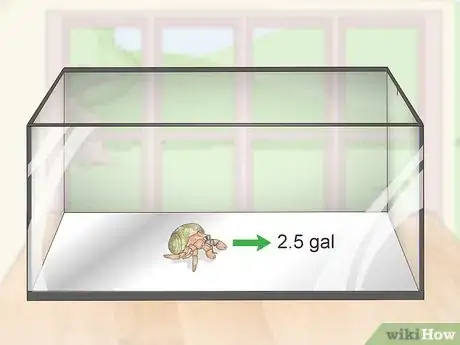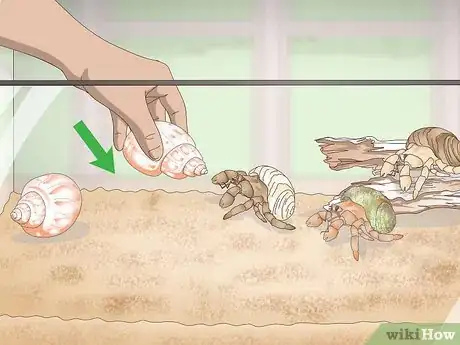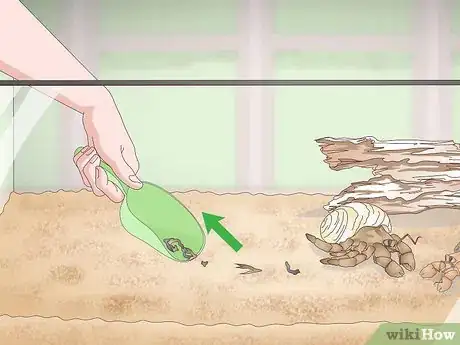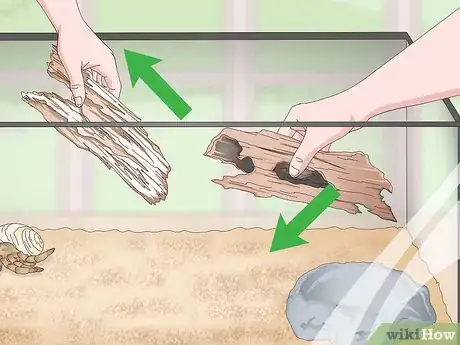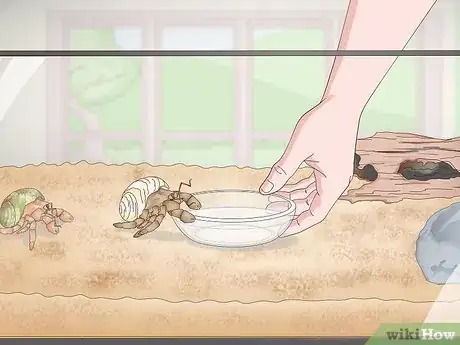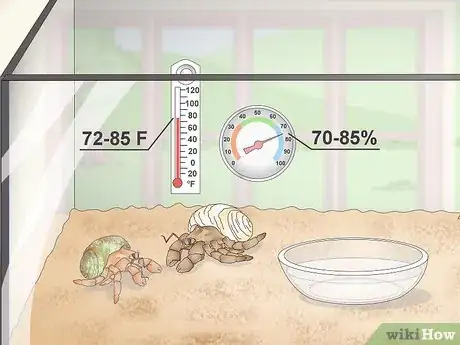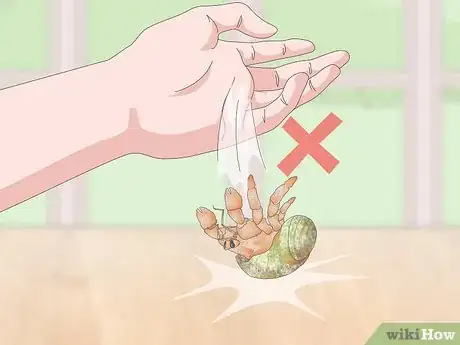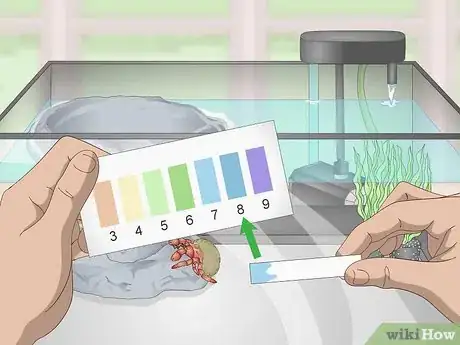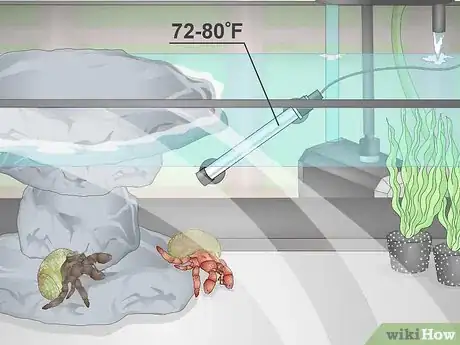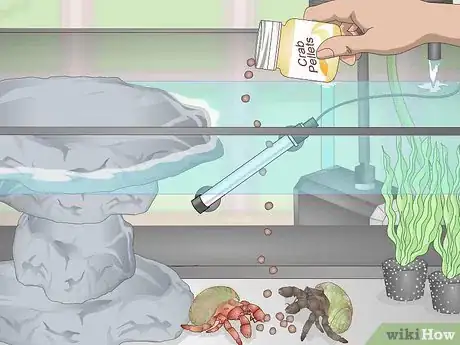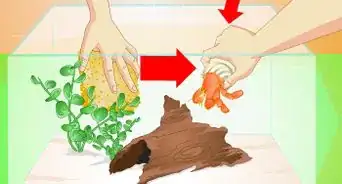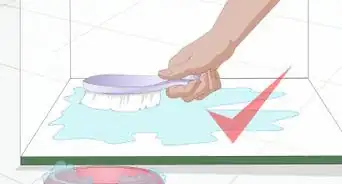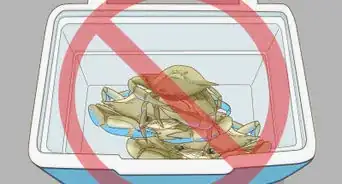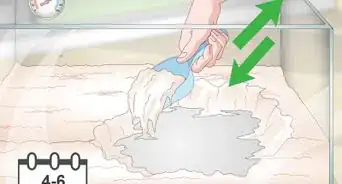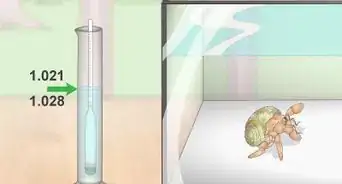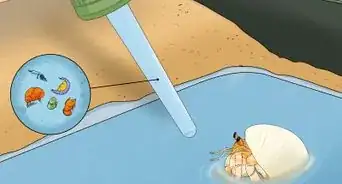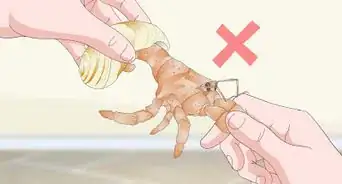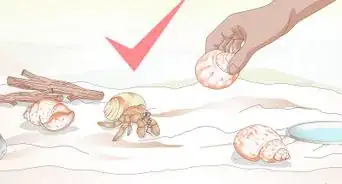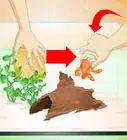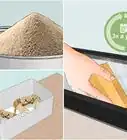This article was co-authored by Marshall Stephens. Marshall Stephens is an Aquarium Expert at Private Oceans Aquariums in West Palm Beach, Florida. Marshall has over 20 years of experience in the aquarium industry and focuses on captive-bred animals. They specialize in tropical and marine aquariums and are a contributor to the Loggerhead Marine life center in Jupiter Florida.
There are 11 references cited in this article, which can be found at the bottom of the page.
wikiHow marks an article as reader-approved once it receives enough positive feedback. In this case, 100% of readers who voted found the article helpful, earning it our reader-approved status.
This article has been viewed 123,891 times.
Did you know that some land hermit crabs have been known to live up to 30 years or more? Even marine hermit crabs can live 2-4 years, which is pretty long in crab years! But if you want your crustacean friend to live a long, happy life, there are some important things you'll need to make sure you're doing to keep it healthy. In this article, we'll walk you through everything you should be doing to ensure your hermit crab is around for a long, long time.
Steps
Providing a Stress-Free Environment for Hermit Crabs
-
1Provide at least 2.5 US gal (9.5 L) of space per medium hermit crab. A 10–20 US gal (38–76 L) aquarium is sufficient for up to 4 medium hermit crabs. Get the aquarium at a pet shop or an aquarium store.[1]
- Don't use a plastic enclosure for hermit crabs, as they do not maintain temperature and humidity well.
- Glass lids are best to control humidity, but make sure they have holes for ventilation.
-
2House hermit crabs in groups of at least 3. Hermit crabs, contrary to their name, are social creatures that live in large groups in the wild. Always house them in groups of at least 3 to keep them happy and healthy.[2]
- Make sure that your aquarium is big enough to house the group of hermit crabs, to avoid overcrowding that can lead to fighting or stress.
Advertisement -
3Provide the hermit crabs with spare shells larger than their current shells. Hermit crabs need different sizes of shells as they molt and grow. Get some clean snail-type shells at a pet shop or aquarium shop. Place them around the tank for the crabs to move in to when they are ready.[3]
- Never use painted shells, because paint contains toxins that can harm the crabs.
- If the crabs don't have enough shells to choose from, they might get aggressive and try to steal shells from each other.
-
4Do not disturb the crabs when they are molting. Hermit crabs will molt, or shed their exoskeleton, 1-2 times a year. They usually become inactive and bury themselves in the sand to do this and are very fragile; so it's important to leave them alone to finish the process in peace.[4]
- Hermit crabs usually eat the skin that they shed. Leave the skins in the tank if you see them, because it is a good source of calcium for them.
Keeping Land Hermit Crabs Healthy
-
1Keep the substrate in your aquarium clean. Spot clean the substrate daily to remove any waste and debris such as leftover food bits. Completely replace the substrate with clean aquarium sand and coconut husk fiber every month. If you see any flies or insects infesting the aquarium, it might also be time to replace the substrate.[5]
- Make sure the tank has at least 6 in (15 cm) of substrate at all times to accommodate medium-sized crabs.
-
2Change out the rocks and driftwood pieces in the aquarium when you clean it. Use clean pieces of driftwood and rocks from an aquarium shop or pet shop. You want to recreate a hermit crab's natural environment; so it's important that they have a variety of things to climb on and hide under.[6]
- Clean the rocks and driftwood in warm water with mild dish soap, rinsing them off thoroughly before you put any pieces back in. Store away anything you are switching out to swap in again the next time you clean the tank.
-
3Keep a clean fresh water bowl and a salt water bowl in the aquarium. Put non-chlorinated fresh water in one dish and make salt water with marine salt to put in the other dish. Change the dishes daily and clean out any slime or dirt in the dishes before you fill them with new water.[7]
- Use dishes that are heavy enough, so that when the crabs climb up them, they won't tip over.
- Get a packet of marine salt at a pet shop or aquarium supply store and follow the directions to mix it with water to create the salt water.
-
4Feed the crabs things like fish pellets, fresh fruit, coconut, bread, and cereal. The best time to feed the crabs is in the evening, because they are nocturnal. Put small amounts of food in the tank and remove any uneaten food in the morning. Provide more food the next feeding if your crabs are eating it all.[8]
- Crabs are not picky about food. You can try feeding them just about any kind of fresh fruits and vegetables and dry snacks to see what they like.
- Consult the directions on packets of fish food to see how much you should feed the crabs.
-
5Keep the tank between 72–85 °F (22–29 °C) with 70-80% humidity. Place both a thermometer and hygrometer in the tank so you can consistently monitor the temperature and humidity. Be sure to make adjustments to the temperature and humidity if they go below or above the recommended levels.[9]
- You can adjust the temperature by adding or removing heat sources, or moving the aquarium to different parts of your house that are cooler or warmer.
- You can adjust the humidity in your tank by putting in smaller or larger water dishes, adding coconut husk fiber to the substrate, or installing a mister or humidifier.
- Heat just one side of your aquarium to allow the hermit crabs to move around to where they feel most comfortable.
-
6Watch out for mites infesting the habitat. Mites are small bugs that are sometimes attracted to hermit crab tanks and can cause the crabs to die. Clean out the tank and wash all the accessories with highly-concentrated marine salt water if you see small bugs crawling on the crabs or in the tank.[10]
- If you see your crabs losing legs, they probably have a mite infestation. Clean the habitat and place the crabs in their salt water dish to bathe them.
- You should also change the substrate in the tank after a mite infestation. Replace it with fresh marine sand and coconut husk fibers.
-
7Handle your hermit crabs with care and don't let them fall on hard surfaces. It's okay to pick up your hermit crabs from time to time by the shell and place them in the palm of your hands. Be careful to hold them above a soft surface, and not too high, in case they wander off and fall.[11]
- Always supervise children if they are handling the crabs.
- Don't handle your crabs the first few days after you bring them home. Allow them time to adjust to their new habitat.
- Feed your hermit crabs well and they are less likely to pinch you. Sometimes excessive pinching means they are grabbing onto anything because they are looking for food.
- Wash your hands with hand soap and warm water before and after handling your crabs.
Keeping Marine Hermit Crabs Healthy
-
1Keep the saltwater in your aquarium at a pH level of 8.0-8.4. Test the pH levels two times a week with an aquarium testing kit from an aquarium shop. Use a liquid, dip, or digital water test kit and follow the directions of the package to test the pH levels in your tank.[12]
- You can purchase water testing kits at an aquarium store or online.
-
2Check the ammonia and nitrite levels with your water test kit twice per week. The levels need to be undetectable, or under 10 ppm. Do a partial water change if the levels are too high and remove excess food and organic matter from the tank to decrease the levels.[13]
- Never replace all the water at once in your aquarium, or you will upset the balance of the levels.
-
3Keep the water temperature between 72–80 °F (22–27 °C). Keep an eye on your aquarium's thermometer every day. Adjust the tank heaters to keep the temperature in the right range.[14]
- You can keep saltwater marine hermit crabs with many other species of tropical saltwater fish because their tank requirements are very similar.
-
4Feed the crabs crab pellets every night following the directions on the packet. Drop the recommended number of pellets into the tank and let them sink to the bottom where the crabs are. Remove any uneaten food from the tank the next morning.[15]
- Small marine hermit crabs can survive on leftover fish food from any other fish in your aquarium, as well as algae and plants that grow in the tank.
Community Q&A
-
QuestionIs it okay if I only have one hermit crab?
 ImbisaleCommunity AnswerYes, but you really should consider getting him a buddy so he won't be lonely. Loneliness is the #1 killer of crabs, because they are used to being in packs/groups in the wild.
ImbisaleCommunity AnswerYes, but you really should consider getting him a buddy so he won't be lonely. Loneliness is the #1 killer of crabs, because they are used to being in packs/groups in the wild. -
QuestionHow many hermit crabs should go in the same cage together?
 OomaCommunity AnswerIt depends on how big the cage is. A cage needs to have enough room to hold your pets, the food and water dishes, extra shells, and toys. You want it to have all that and plenty of room to roam around.
OomaCommunity AnswerIt depends on how big the cage is. A cage needs to have enough room to hold your pets, the food and water dishes, extra shells, and toys. You want it to have all that and plenty of room to roam around. -
QuestionShould I put my hermit crab in saltwater? I found it in the ocean.
 Community AnswerYes, use saltwater in its aquarium. Leave a bit of dry land for it, too.
Community AnswerYes, use saltwater in its aquarium. Leave a bit of dry land for it, too.
References
- ↑ https://en.wikibooks.org/wiki/Animal_Care/Land_hermit_crab
- ↑ https://en.wikibooks.org/wiki/Animal_Care/Land_hermit_crab
- ↑ https://www.britannica.com/animal/hermit-crab
- ↑ http://pethermitcrabs.org/shells-molting/
- ↑ https://pets.stackexchange.com/questions/751/how-often-should-a-hermit-crab-tank-be-cleaned
- ↑ https://www.vetbabble.com/small-pets/hermit-crabs/
- ↑ https://www.vetbabble.com/small-pets/hermit-crabs/
- ↑ http://pethermitcrabs.org/food-diet/
- ↑ https://www.hermit-crabs.com/care.html
- ↑ http://www.hermitcrabassociation.com/pages/mites.html
- ↑ http://www.plightofthehermies.org/adopt/
- ↑ https://www.petguide.com/blog/fish/the-benefits-of-hermit-crabs-in-your-aquarium/
- ↑ https://www.petguide.com/blog/fish/the-benefits-of-hermit-crabs-in-your-aquarium/
- ↑ https://www.fishlore.com/Profiles-HermitCrab.htm
- ↑ https://www.petguide.com/blog/fish/the-benefits-of-hermit-crabs-in-your-aquarium/
About This Article
To make your land hermit crab live for a long time, feed it a healthy, balanced diet that consists of fish pellets, fresh fruit, and vegetables. Also, provide your hermit crab with a bowl of non-chlorinated freshwater and a bowl of marine saltwater at all times so it can bathe and drink. You should also clean the substrate in your hermit crab's tank every day and replace it completely every 6 months so your crab doesn't get sick. To learn how to keep a marine hermit crab healthy, scroll down!
